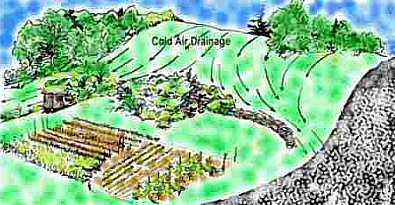 |
 |
| Home | Welcome | What's New | Site Map | Glossary | Weather Doctor Amazon Store | Book Store | Accolades | Email Us |
 | |||||||||
Frost PocketsThe lengthening nights during the late summer and autumn bring noticeably colder minimum temperatures across most of North America. If such nights have clear skies and fairly calm regional winds, the potential for temperatures to fall below the freezing mark increases as the days move on toward winter. This is especially true in low-lying terrain, hollows and drainage bottoms where cold air can pool. Such areas are more susceptible to frost than the surrounding terrain and are therefore known as frost pockets. When air at higher elevations cools — say, during nighttime radiational heat loss — it becomes much heavier than the surrounding air as well as air layers well beneath it. Its negative buoyancy causes it to sink downward until it reaches a layer of air cooler than itself or bottoms out against the earth's surface. The preferred cold-air drainage route descends downhill following the same local terrain drainage patterns taken by rain or snow runoff. Once it has reached its resting level, it may continue to cool through radiational heat loss to even lower temperatures. Cold-air drainage flows can occur even with terrain differences of only a metre (a few feet). These pools of colder air are often observed in warmer weather as patches of light fog forming over low-lying wetlands, ponds and stream beds, or wet vegetation. In colder weather, when the cold air drops below the freezing mark, frost will form in these locations, forming the frost pocket.  Terrain Effects on Cold-Air DrainageCold-air and frost pockets are commonly found in areas where air at higher elevations chills due to radiational cooling or contact with snowpacks or glaciers, and the cold air then drains downslope. In the extreme cases — i.e., with very cold temperatures and/or steep slopes — these drainage flows, known as katabatic winds, may attain great speeds, as high as 70 km/h (44 mph), but usually they slide gently downhill at 7-12 km/h (4-8 mph). Of course, when the air temperature falls below freezing, it can damage plants caught in the pool or chilled in the passing flow. Extremely susceptible plants, such as tomatoes and peppers, may even be harmed by near-freezing temperatures. In rugged terrain such as found in the western cordillera, cold-air/frost pocket regions can produce totally different micro-ecosystem with a substantially shorter growing season over short distances. Although our focus here is on the colder temperatures of late summer/early autumn, the same conditions may occur in spring and early summer when plants are more susceptible to frost damage. But since cold air flows downhill like water, it can also be diverted — and even halted — by terrain features such as rock outcrops, thick hedges, earth berms, or dense stands of trees. That fact has not been lost on farmers, vineyard growers and gardeners who have taken the hint and created artificial barriers to divert the cold air flow around their fields and plants. These frost dams, are most often dense collections of shrubs and low conifers with tight fencing, although buildings will work too. 
Frost Dams Can Protect Sensitive Crops From DamageWhile artificial frost dams are generally considered for agricultural or horticultural protection, the concept can also be used in landscaping around homes and outbuildings to reduce or increase cold air pooling around them. By diverting cold air drainage around a home, for example, a few dollars each year may be saved in heating costs. And in the right location, controlling cold air drainage toward the home could funnel cooler air around it and reduce the summer air-conditioning bill. Learn More From These Relevant Books
|
|||||||||
 |
To Purchase Notecard, |
Now Available! Order Today! | |
 |
 |
NEW! Now Available in the US! |
The BC Weather Book: |


